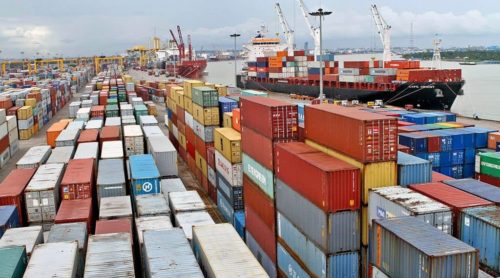US Maritime Regulator Increases Scrutiny of Major Container Alliances

Container depot
WMN..The US Federal Maritime Commission (FMC) has decided to increase monitoring report requirements for the three major container shipping alliances.
As informed, the FMC issued letters to 2M, THE Alliance and Ocean Alliance requiring that certain carrier-specific trade data currently filed with the commission quarterly, must now be submitted on a monthly basis.
A commission’s Bureau of Trade Analysis (BTA) has traditionally relied on a combination of individual vessel operator confidentially provided data and information from commercially available industry data to monitor and analyze container carrier freight rates and service market trends.
However, the BTA has determined that given recent fluctuations in the markets, it needs to receive key trade data directly from alliance carriers on a more frequent basis in order to better position staff economists to timely evaluate changes in the transpacific and transatlantic trades and report findings to the commission.
Container shipping enjoys profitable year despite challenges
The announcement came as container shipping sector enjoyed strong earnings in the third quarter of this year, with freight rates expected to further grow amid port congestion and peak season surcharge. Major container lines reported their best third-quarter earnings since 2010 thanks to a combination of factors including capacity discipline, shortage of container boxes, higher freight rates and lower operating costs associated with low bunker costs.
“There is money to be made by both carriers and tonnage providers as volumes defy usual seasonality and remain strong into the fourth quarter of the year. On top of that, low bunker prices –, one of the keys to high profitability this year – look set to stick around,” BIMCO said.
The increase in charter rates is said to reflect the higher demand for ships. Alphaliner estimates the idle fleet stood at 378,802 TEU at the start of November – an 86.1% drop from the peak of 2.72 million TEU being idle in May.
Higher demand is particularly strong on the front-haul transpacific trade from Asia to North America. Following the disruption in the early months of the pandemic, strong US retail sales and a need to restock low inventories resulted in a strong peak season, which – unusually – continued after the Chinese Golden Week and further into October.
The US West Coast (USWC) has seen the largest growth compared with last year. Volumes here were up by 276,712 TEU in the third quarter compared with 2019. On both US coasts, the third quarter is the first with year-on-year growth compared with the previous quarter, though the increase on the US East Coast (USEC) is smaller at 82,564 TEU.
Over the first nine months of the year, the USWC is down by 4.4% and the USEC by 4.3%, compared with the same period of 2019. The USWC saw a much larger drop in the first quarter. It was hit hard by the factory closures/lockdowns in China, but has seen higher growth in the third quarter than the USEC, leaving them both with similar percentage drops.
The extra containers into the US in the third quarter of the year came primarily from the Far East, with volumes between here and North America in Q3 up 18.7% compared with Q3 2019. This was enough to bring accumulated exports over the first three quarters into positive territory for the first time in October, with year-on-year growth up 1.7%.
However, even though the worst-case scenario has been avoided this year, the outlook for container shipping remains clouded, BIMCO warned. A number of factors are expected to determine carriers’ profitability.
FMC puts spotlight on container alliances
A core function of the FMC is the monitoring of ocean carrier alliance agreements filed with the agency. The FMC receives and evaluates exhaustive, commercially sensitive information from regulated entities, in this case, parties to an ocean carrier alliance agreement.
That information is carefully analyzed, along with other information that permits FMC staff to determine trends in the marketplace and the potential for illegal behavior.
The FMC’s section 6(g) review and oversight responsibility for filed agreements is ongoing and continues after a filed agreement has gone into effect. The FMC said it prioritizes its continuous monitoring of the 300 plus cooperative agreements currently filed with the commission.
Specifically, the three major global carrier alliances are the top priority and receive the highest scrutiny, FMC pointed out. These three agreements have the greatest potential to cause or facilitate adverse market effects based on the agreement’s authority and geographic scope in combination with underlying market conditions.
On an ongoing basis, the FMC monitors key economic indicators and changes to underlying market conditions for all global alliance agreements to detect any joint activity by agreement members that might raise and maintain freight rates above competitive levels, or unreasonably decrease services. For these agreements, FMC staff conducts more detailed reviews, and periodically presents current findings and recommendations to the commission.
“If we detect any indication of carrier behavior that may violate the Shipping Act’s section 6(g) competition standard, we will immediately seek to address these concerns with direct carrier discussions,” FMC Chairman Michael Khouri said.
“If necessary, the FMC will go to federal court to seek an injunction to enjoin further operation of the alliance agreement.”
• Culled from World Maritime News..
As informed, the FMC issued letters to 2M, THE Alliance and Ocean Alliance requiring that certain carrier-specific trade data currently filed with the commission quarterly, must now be submitted on a monthly basis.
A commission’s Bureau of Trade Analysis (BTA) has traditionally relied on a combination of individual vessel operator confidentially provided data and information from commercially available industry data to monitor and analyze container carrier freight rates and service market trends.
However, the BTA has determined that given recent fluctuations in the markets, it needs to receive key trade data directly from alliance carriers on a more frequent basis in order to better position staff economists to timely evaluate changes in the transpacific and transatlantic trades and report findings to the commission.
Container shipping enjoys profitable year despite challenges
The announcement came as container shipping sector enjoyed strong earnings in the third quarter of this year, with freight rates expected to further grow amid port congestion and peak season surcharge. Major container lines reported their best third-quarter earnings since 2010 thanks to a combination of factors including capacity discipline, shortage of container boxes, higher freight rates and lower operating costs associated with low bunker costs.
“There is money to be made by both carriers and tonnage providers as volumes defy usual seasonality and remain strong into the fourth quarter of the year. On top of that, low bunker prices –, one of the keys to high profitability this year – look set to stick around,” BIMCO said.
The increase in charter rates is said to reflect the higher demand for ships. Alphaliner estimates the idle fleet stood at 378,802 TEU at the start of November – an 86.1% drop from the peak of 2.72 million TEU being idle in May.
Higher demand is particularly strong on the front-haul transpacific trade from Asia to North America. Following the disruption in the early months of the pandemic, strong US retail sales and a need to restock low inventories resulted in a strong peak season, which – unusually – continued after the Chinese Golden Week and further into October.
The US West Coast (USWC) has seen the largest growth compared with last year. Volumes here were up by 276,712 TEU in the third quarter compared with 2019. On both US coasts, the third quarter is the first with year-on-year growth compared with the previous quarter, though the increase on the US East Coast (USEC) is smaller at 82,564 TEU.
Over the first nine months of the year, the USWC is down by 4.4% and the USEC by 4.3%, compared with the same period of 2019. The USWC saw a much larger drop in the first quarter. It was hit hard by the factory closures/lockdowns in China, but has seen higher growth in the third quarter than the USEC, leaving them both with similar percentage drops.
The extra containers into the US in the third quarter of the year came primarily from the Far East, with volumes between here and North America in Q3 up 18.7% compared with Q3 2019. This was enough to bring accumulated exports over the first three quarters into positive territory for the first time in October, with year-on-year growth up 1.7%.
However, even though the worst-case scenario has been avoided this year, the outlook for container shipping remains clouded, BIMCO warned. A number of factors are expected to determine carriers’ profitability.
FMC puts spotlight on container alliances
A core function of the FMC is the monitoring of ocean carrier alliance agreements filed with the agency. The FMC receives and evaluates exhaustive, commercially sensitive information from regulated entities, in this case, parties to an ocean carrier alliance agreement.
That information is carefully analyzed, along with other information that permits FMC staff to determine trends in the marketplace and the potential for illegal behavior.
The FMC’s section 6(g) review and oversight responsibility for filed agreements is ongoing and continues after a filed agreement has gone into effect. The FMC said it prioritizes its continuous monitoring of the 300 plus cooperative agreements currently filed with the commission.
Specifically, the three major global carrier alliances are the top priority and receive the highest scrutiny, FMC pointed out. These three agreements have the greatest potential to cause or facilitate adverse market effects based on the agreement’s authority and geographic scope in combination with underlying market conditions.
On an ongoing basis, the FMC monitors key economic indicators and changes to underlying market conditions for all global alliance agreements to detect any joint activity by agreement members that might raise and maintain freight rates above competitive levels, or unreasonably decrease services. For these agreements, FMC staff conducts more detailed reviews, and periodically presents current findings and recommendations to the commission.
“If we detect any indication of carrier behavior that may violate the Shipping Act’s section 6(g) competition standard, we will immediately seek to address these concerns with direct carrier discussions,” FMC Chairman Michael Khouri said.
“If necessary, the FMC will go to federal court to seek an injunction to enjoin further operation of the alliance agreement.”
• Culled from World Maritime News..





